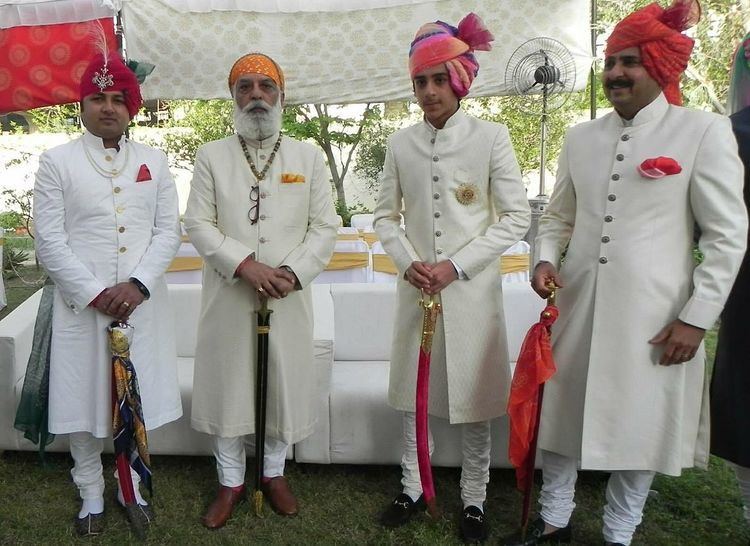 | ||
Sherwani (Hindi: शेरवानी; Urdu: شیروانی; Bengali: শেরওয়ানি) is a long coat-like garment worn in the Indian subcontinent, very similar to a British frock coat or a Polish żupan. It was traditionally associated with the Indian subcontinent. It is worn over a kurta with the combination of either a churidar, a dhoti, a pajama, or a salwar as the lower-body clothing. It can be distinguished from the achkan by the fact that it is shorter in length, is often made from heavier suiting fabrics, and by the presence of a lining.
Contents
History
The sherwani originated in the 19th century British India as the European style court dress of nobles and royals of the Mughal dynasty, before being more generally adopted in the late 19th century. It appeared as a fusion of the British frock coat and a kurta and pajama, first at Lucknow in 1820's. It was gradually adopted by rest of the Indian royalty and aristocracy, and later by the general population, as a more evolved form of occasional traditional attire.
Bangladesh
In Bangladesh, the sherwani or the achkan is worn by people on formal occasions such as weddings and eid.
India
In India, the achkan sherwani is generally worn for formal occasions in winter, especially by those from Rajasthan, Punjab, Delhi, Jammu, Uttar Pradesh and Hyderabad. The achkan sherwani is generally associated with the Hindus while the simple sherwani was historically favoured by Muslims. The two garments have significant similarities, though sherwanis typically are more flared at the hips and achkans are lengthier than simple sherwanis. The achkan later evolved into the Nehru Jacket, which is popular in India. In India, the achkan or sherwani is generally worn with the combination of Churidar as the lower garment.
Pakistan
After the independence of Pakistan, Mohammad Ali Jinnah frequently wore the sherwani. Following him, most government officials in Pakistan such as the President and Prime Minister started to wear the formal black sherwani over the shalwar qameez on state occasions and national holidays. But as Dr Tariq Rahman writes about the European style officers that "the impeccably dressed South Asian officers, both civilian and military, never wore in public till the 1970s when Prime Minister Zulfikar Ali Bhutto gave respectability to this dress by wearing it in public". However, General Muhammad Zia-ul-Haq made it compulsory for all officers to wear sherwani on state occasions and national holidays.
Sri Lanka
In Sri Lanka, it was generally worn as the formal uniform of Mudaliyars and early Tamil legislators during the British colonial period. The diplomatic service had incorporated its use for formal occasions overseas.
Modern sherwanis
Sherwanis are mostly worn in India, Bangladesh and Pakistan. These garments usually feature detailed embroidery or patterns. One major difference between sherwani wearing habits is the choice of lower garment, while in India, the dress is distinguished by their preference for churidars or dhotis, in Pakistan and Bangladesh, it is mainly worn with shalwar instead.
Sherwanis have also been designed by the Indian designer, Rohit Bal for British Airways cabin crews serving on flights to India. Music director A.R. Rahman also appeared in a black sherwani to receive an Academy Award.
Pakistani journalist, filmmaker and activist, Sharmeen Obaid-Chinoy appeared in sherwani to receive Academy Award in 2012 and 2015.
